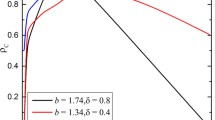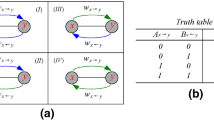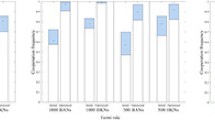Abstract
We propose a novel dynamic link weight adjustment model, in which link weights on static network will be dynamically adjusted according to agents’ influence during the evolutionary process. To be specific, when an agent’s strategy is learned by one of his direct neighbors, his influence will be expanded by one unit \(\beta \). Then link weights between agents will be adaptively adjusted by counting the influence of agents. Meanwhile, we utilize a variable \(\delta \) to control the range of link weights, that is, link weights can only be limited within the interval \([1-\delta ,1+\delta ]\). In our model, it should be noted that link weights between agents will be integrated into the fitness calculation process. Through abundant simulations, the results indicate that the newly proposed model can significantly foster the persistence and emergence of cooperation. In addition, when the cost-to-benefit ratio u is quite small, the level of cooperation will increase with the augmentation of \(\delta \). However, when the cost-to-benefit ratio u exceeds a certain value, the level of cooperation increases at the early stage and then decreases with the growth of \(\delta \). As for the potential reasons, we observe that it is closely related to the type of connections, in which the cooperation can flourish once \(C-C\) type links dominate the system, while other types will hamper the evolution of cooperation. Taking together, the current model and results will provide some insights into the collective cooperation within the human population.
Graphic abstract
We propose a novel dynamic link weight adjustment model, in which link weights on static network will be dynamically adjusted according to agents’ influence during the evolutionary process. In this figure, the color phase encodes the frequency of cooperation \(\rho \)C on \(\delta -\varDelta \) parameter plane for a series values of cost-to-benefit ratio u. Panels (a) to (f) are obtained at the cost-to-benefit ratio u=0.01, u=0.015, u=0.02, u=0.025, u=0.03, and u=0.035, respectively. It can be found that when u is quite small, the level of cooperation increases with the augmentation of \(\delta \), while the parameter \(\varDelta \) seems to have no significant impact on the evolution of cooperation. Similar with previous discussion, when the cost-to-benefit ratio u exceeds to a certain value, the level of cooperation presents the first increase and then decrease with the increase of \(\delta \). In addition, when the parameter \(\delta \) reaches a certain value, the level of cooperation decreases as \(\varDelta \) gradually grows. All these observations suggest that there is an optimal combination \(\delta -\varDelta \) promoting the evolution of cooperation. All results are obtained at L=100, MCS=\(3\times 10^4, \beta =1\) and K=0.1.








Similar content being viewed by others
Data Availability Statement
This manuscript has no associated data or the data will not be deposited. [Authors’ comment: There are no external data associated with the manuscript.]
References
T. Cluttonbrock, Nature 462, 51 (2009)
C. Darwin, Am. Anthropol. 61, 176 (1963)
G. Hardin, Science 162, 1243 (1968)
J. Nash, Proc. Natl. Acad. Sci. USA 36, 48 (1950)
M.A. Nowak, K. Sigmund, Nature 355, 250 (1992)
T. Clutton-Brock, Nature 462, 51 (2009)
R. Axelrod, W.D. Hamilton, Science 211, 1390 (1981)
G.G. McNickle, R. Dybzinski, Ecol. Lett. 16, 545 (2013)
G.M. Hodgson, K.N. Huang, J. Evolut. Econ. 22, 345 (2012)
R. Kummerli, C. Colliard, N. Fiechter, B. Petitpierre, F. Russier, L. Keller, Proc. R. Soc. B 274, 2965 (2007)
M. Perc, New J. Phys. 8, 22 (2006)
F. Zhang, J. Wang, H.Y. Gao, X.P. Li, C.Y. Xia, Eur. Phys. J. B 94, 22 (2021)
T. Lin, T. Alpcan, K. Hinton, IEEE Syst. J. 11, 649 (2017)
X.Y. Li, T. Chen, Q. Chen, X.Y. Zhang, Eur. Phys. J. B 93, 204 (2020)
J.M. Smith, G.R. Price, Nature 246, 15 (1973)
M. Perc, O. Petek, S.M. Kamal, Appl. Math. Comput. 249, 19 (2014)
S.S. Komorita, J. Exp. Psychol. 12, 357 (1976)
M. Perc, A. Szolnoki, Phys. Rev. E 77, 011904 (2008)
M. Perc, Z. Wang, PLoS One 5, e15117 (2010)
A. Szolnoki, M. Perc, Z. Danku, Phys. A 387, 2075 (2008)
Z. Wang, L. Wang, A. Szolnoki, Eur. Phys. J. B 88, 124 (2015)
Q. Jian, X.P. Li, J. Wang, C.Y. Xia, Appl. Math. Comput. 396, 125928 (2021)
M.A. Nowak, R.M. May, Nature 359, 826 (1992)
X.H. Deng, Y. Liu, Z.G. Chen, Physca A 389, 5173 (2010)
F.C. Santos, J.M. Pacheco, Phys. Rev. Lett. 95, 098104 (2005)
X.K. Meng, S.W. Sun, X.X. Li, L. Wang, C.Y. Xia, J.Q. Sun, Phys. A 442, 388 (2016)
J. Wang, W.W. Lu, L.N. Liu, L. Li, C.Y. Xia, PLoS One 11, e0167083 (2016)
F. Fu, T. Wu, L. Wang, Phys. Rev. E 79, 036101 (2009)
X.P. Li, S.W. Sun, C.Y. Xia, Appl. Math. Comput. 361, 810 (2019)
Z.L. Xiao, X.J. Chen, New J. Phys. 22, 023012 (2020)
W.J. Li, L.L. Jiang, M. Perc, Appl. Math. Comput. 391, 125705 (2021)
A. Szolnoki, M. Perc, New J. Phys. 15, 053010 (2013)
C.Y. Xia, X.P. Li, Z. Wang, M. Perc, New J. Phys. 20, 75005 (2018)
W.X. Wang, J. Ren, G.R. Chen, B.H. Wang, Phys. Rev. E 74, 056113 (2006)
W.W. Lu, J. Wang, C.Y. Xia, Phys. Lett. A 382, 3058 (2018)
C.B. Sun, C. Luo, Appl. Math. Comput. 374, 125063 (2020)
X.P. Li, H.B. Wang, G. Hao, C.Y. Xia, Phys. Lett. A 384, 126414 (2020)
K.K. Huang, X.P. Zheng, Z.J. Li, Y.Q. Yang, Sci. Rep. 5, 14783 (2015)
C. Shen, C. Chu, L. Shi, M. Perc, Z. Wang, Roy. Soc. Open Sci. 5, 180199 (2018)
C. Chu, J.Z. Liu, C. Shen, J.H. Jin, Y.X. Tang, L. Shi, Chaso Soliton Fractals 104, 28 (2017)
H. Guo, C. Chu, C. Shen, L. Shi, Chaos Solitons Fractals 109, 265 (2018)
C. Hauert, G. Szabó, Am. J. Phys. 73, 405 (2005)
Z. Wang, M. Perc, Hashimoto Phys. Rev. E 82, 021115 (2010)
Q. Su, A. McAvoy, L. Wang, N.A. Nowak, Hashimoto Proc. Natl Acad. Sci. USA 116, 25398 (2019)
G. Szabó, C. Töke, Phys. Rev. E 652, 69 (1998)
Y.T. Dong, G. Hao, J. Wang, C. Liu, C.Y. Xia, Phys. Lett. A 383, 1157 (2019)
X.P. Li, H.B. Wang, C.Y. Xia, M. Perc, Front. Phys-Lausanne 7, 125 (2019)
T. Wu, F. Fu, P.X. Dou, L. Wang, Phys. A 413, 86 (2014)
M. Cardinot, J. Griffith, C. O’Riordan, Phys. A 493, 116 (2018)
A. Szolnoki, M. Perc, Eur. Phys. J. B 67, 337 (2009)
J.Q. Li, J.W. Dang, J.L. Zhang, Appl. Math. Comput. 369, 124837 (2020)
T. Khoo, F. Fu, S. Pauls, Sci. Rep. 6, 36293 (2016)
D.G. Rand, N.A. Christakis, Proc. Natl. Acad. Sci. USA 108, 19193 (2011)
Acknowledgements
This project is partially supported by the Project of National Defense Science and Technology Innovation under Grant no. DF20190050.
Author information
Authors and Affiliations
Contributions
CZ and XZ designed the model, analyzed the results and wrote the manuscript. All authors gave the final approval for publication.
Corresponding author
Rights and permissions
About this article
Cite this article
Zhao, C., Zhang, X. Role of influence-induced dynamic link weight adjustment in the cooperation of spatial prisoner’s dilemma game. Eur. Phys. J. B 94, 112 (2021). https://doi.org/10.1140/epjb/s10051-021-00079-x
Received:
Accepted:
Published:
DOI: https://doi.org/10.1140/epjb/s10051-021-00079-x




